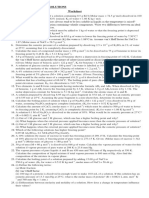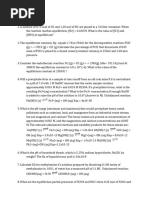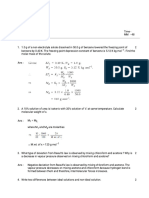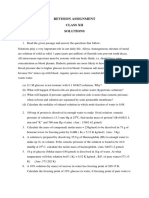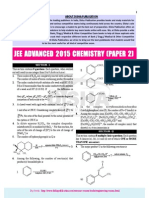Tutorial 1 - Answers
Uploaded by
Raymond KakalaTutorial 1 - Answers
Uploaded by
Raymond KakalaFAC0025, Trimester January 2013
CHEMISTRY II (FAC0025)
TUTORIAL 1
1.
Look at following reactions and find which ones of them have solubility increasing
with temperature.
I. XY(s) + Heat X2+(aq) + Y2II. XY2(s) X2+ (aq) + 2Y- (aq) + Heat
III. XY3(s) X3+ (aq) + 3Y-(aq) + Heat
Answer:
In endothermic solutions, solubility increases with increasing temperature. Thus,
since I. is endothermic reaction solubility of it increases with increasing temperature.
II and III are exothermic reactions, so solubility of them decreases with temperature.
2.
What is the order of solubility of NaCl in the following solvents;
I. Pure water
II. NaNO3(aq)
III. Na2SO4(aq)
Answer:
Solubility of NaCl in pure water is larger than others since they have no common
ions. NaCl has one common ion with NaNO3 and 2 common ion with Na2SO4.
Increase in the number of common ion decreases solubility. Thus; I>II>III
3.
Why is it that ceric sulphate which is a solid inorganic salt becomes less soluble in
water as the temperature increases?
Answer:
Cerium (III) sulfate, become less soluble in water as temperature increases. This
temperature dependence is sometimes referred to as retrograde or inverse solubility,
and exists when a salt's dissolution is exothermic (according to Le Chatelier's
principle, extra heat will cause equilibrium for an exothermic process to shift
towards the reactants). So the dissolution of ceric sulphate decreases with the
increase in the temperature.
4.
Hydrogen sulfide, H2S, is a toxic gas responsible for the odor of rotten eggs. The
solubility of H2S (g) in water at STP is 0.195 M. What is the solubility in water at
0oC and a partial pressure of 25 mm Hg.
FAC0025, Trimester January 2013
Answer:
STP Temperature = 0oC, pressure = 1 atm
S kPg Henry's law constant, k
P 25 mm Hg
S
M
0.195
pg
atm
1 atm
0.03289 atm
760 mm Hg
3
solubility of H 2 S at 25 mm Hg S kPg 0.195
0.0336 6.414 10 M
atm
5.
The vapor pressure of pure water at 600C is 149 torr. The vapor pressure of water
over a solution at 600C containing equal numbers of moles of water and ethylene
glycol is 67 torr. Is the solution ideal in terms of Raoults law? Justify your answer.
Answer:
Ideal solutions obey Raoults law. Calculate the vapor pressure predicted by Raoults
law and compare it to the experimental vapor pressure. Assume ethylene glycol (eg)
is the solute.
H O eg 0.500; PA A PA0 0.500(149) torr 74.5 torr
2
The vapor pressure of the solution (PA), 67 torr, is less than the value predicted by
Raoults law for an ideal solution. The solution is non-ideal.
6.
At 63.50C, the vapor pressure of H2O is 175 torr, and that of ethanol, C2H5OH, is 400
torr. A solution is made by mixing equal masses of H2O and C2H5OH.
(a) What is the mole fraction of ethanol in the solution?
(b) Assuming ideal-solution behavior, what is the vapor pressure of the solution at
63.50C?
(c) What is the mole fraction of ethanol in the vapor pressure above the solution?
Answer:
0
At 63.50 C, PH02O 175 torr , PEth
400 torr
Let G the mass of H 2 O and / or C2 H 5OH
(a) Eth
G
46.07 g C 2 H 5 OH
G
G
46.07 g C 2 H 5 OH 18.02 g H 2 O
2
FAC0025, Trimester January 2013
Multiplying top and bottom of the right side of the equation by 1/G gives:
Eth
1
46.07
1
1
46.07 18.02
0.02171
0.2812
0.02171 0.05549
(b)
0
PT PEth PH 2O ; PEth Eth PEth
; PH 2O H 2O PH02O
Eth 0.2812, PEth 0.2812(400 torr ) 112.48 112 torr
H O 1 0.2812 0.7188 ; PH O 0.7188(175 torr ) 125.8 126 torr
2
P 112.5 torr 125.8 torr 238.3 238 torr
T
(c) Eth in vapor
7.
PEth
112.5 torr
0.4721 0.472
Ptotal 238.3 torr
Lactose, C12H22O11, is a naturally occurring sugar found in mammalian milk. A
0.335 M solution of lactose in water has a density of 1.0432 g/mL at 20oC. Calculate:
(a) the mole fraction,
(b) the mass percentage,
(c) the molality of the solution.
Answer:
MW C12H22O11 = 342.30 g/mol
Assume 1.00 L solution
Mass of solution = (1000 mL)(1.0432 g/ml) = 1043.2 g
g
114.7 g C12 H 22 O11
mol
mass of H2 O 1043.2 114.7 928.5 g H2 O
mass of solute 0.335 mol 342.0
mol C12 H 22 O11 0.335 mol
928.5 g
51.53 mol
g
18.02
mol
0.335
a) mol fraction, X C12H 22O11
0.00646
0.335 51.53
114.7 g
b) mass % C12 H 22 O11
100 11.0 mass %
1043.2 g
mol H2 O
c) molality
0.335 mol
0.361m
0.9285 kg
8.
Using
data
from Table 7,
calculate the
FAC0025, Trimester January 2013
freezing and boiling points of each of the following solutions.
(a) 0.17 m glycerol in ethanol
(b) 1.92 mol of naphthalene, C10H8, in 16.8 mol chloroform
(c) 5.44 g KBr and 6.35 g glucose, C6H12O6, in 200 g of water
Table 7
Solvent
Normal Boiling
Point (0C)
Kb
(0C/m)
Normal Freezing
Point (0C)
Kf
(0C/m)
Water, H2O
100.0
0.52
0.0
1.86
Benzene, C6H6
80.1
2.53
5.5
5.12
Ethanol, C2H5OH
78.4
1.22
-114.6
1.99
Carbon tetrachloride, CCl4
76.8
5.02
-22.3
29.8
Chloroform, CHCl3
61.2
3.63
-63.5
4.68
Answer:
T = K (m) ; first, calculate the molality of each solution
(a) 0.17 m
16.8 mol CHCl3
(b)
119.4 g CHCl3
2.006 2.01 kg;
mol CHCl3
1.92 mol C 10 H 8
0.9571 0.957 m
2.006 kg CHCl3
5.44 g KBr
1 mol KBr
2 mol particles
0.09143 0.0914 mol particles
119.0 g KBr
1 mol
(c) 6.35 g C 6 H 12O6
m
1 mol C 6 H 12O6
0.0352 mol particles
180.2 g C 6 H 12O6
0.09413 0.03524 mol
particles
0.200 kg H 2 O
0.63335 0.633 m
Then, f.p. = Tf Kf(m); b.p. = Tb + Kb(m); T in 0C
FAC0025, Trimester January 2013
(a)
(b)
(c)
9.
m
0.17
0.957
0.633
Tf
-114.6
-63.5
0.0
-Kf(m)
-1.99(0.17) = -0.34
-4.68(0.957) = -4.48
-1.86(0.633) = -1.20
f.p.
-114.9
-68.0
-1.2
Tb
78.4
61.2
100.0
+Kb(m)
1.22(0.17) = 0.21
3.63(0.957) = 3.47
0.52(0.633) = 0.33
b.p.
78.6
64.7
100.3
Lysozyme is an enzyme that breaks bacterial cell walls. A solution containing 0.150
g of this enzyme in 210 mL of solution has an osmotic pressure of 9.53 torr at 25 0C.
What is the molar mass of this substance?
Answer:
MRT ; M
; T 25 0 C 273 298 K
RT
1 atm
K mol
1
M 9.53 torr
5.128 10 5 5.13 M
760 torr 0.08206 L atm 298 K
mol M L 5.128 10 5 0.210 L 1.077 10 5 1.08 10 4 mol lysozyme
MM
0.150 g
g
g
1.39 10 3
lysozyme
4
mol 1.077 10 mol
mol
10. (a) Calculate how much strontium fluoride will dissolve in 1 L of water given
Ksp = 2.5 x 10-9 at 25oC.
SrF2(s)
Sr2+(aq)
+
2F-(aq)
to
a
0
0
Change
-x
+x
+2x
Eqm
(a-x)
x
2x
Answer:
i.
ii.
iii.
iv.
v.
Write the equation for dissolving SrF2 in water:
SrF2(s) Sr2+(aq) + 2F-(aq)
Write the equilibrium expression:
Ksp = [Sr2+][F-]2 = 2.5 x 10-9
Determine the relative concentrations of each ion:
at equilibrium [Sr2+] = x and [F-] = 2x (from the balanced chemical
equation)
Substitute these vales into the equilibrium expression:
2.5 x 10-9 = [x][2x]2 = 4x3
Solve for x:
2.5 x 10-9 4 = x3 = 6.25 x 10-10
x = 36.25 x 10-10 = 8.5 x 10-4M
The solubility of SrF2 at 25oC is 8.5 x 10-4 M
8.5 x 10-4 moles of SrF2 will dissolve in 1L of water at 25oC.
FAC0025, Trimester January 2013
(b) Chemical analysis gave [Sr2+] = 0.012 M, and [F-] = 0.024 M in a solution. Is the
solution saturated, supersaturated or unsaturated?
Answer:
Qsp = [0.012] [0.024]2 = 6.9 x 10-6 > 2.5 x 10-9 (Ksp).
This question deals with the concept of ion product, Qsp.
If Qsp = [Pb2+][Br-]2 > Ksp the solution is supersaturated.
(c) Will a precipitate form if 0.100 L of 0.30 M Ca(NO3)2 is mixed with 0.200 L of
0.060 M NaF? (Ksp for CaF2 at 25oC is 3.2 x 10-11)
Answer:
Method: Calculate Qsp and compare with Ksp.
First: What is the sparingly soluble salt? NaNO3, like all Na+ and NO3- salts, is
very soluble in water it must be CaF2.
CaF2 (s) Ca2+ (aq) + 2 F- (aq)
Ksp = [Ca2+][F-]2 need [Ca2+] and [F-].
a) We start with 0.30 M Ca(NO3)2 = 0.30 M [Ca2+] (100% dissociation)
b) We start with 0.060 M NaF = 0.060 M [F-]
(100% dissociation)
-- but we are mixing two solutions, therefore both will be diluted.
Remember:
[Ca2+]f =
MiVi = MfVf
(i = initial, f = final)
[Ca 2 ]i Vi
(0.30 M)(0.100 L)
=
(0.200 L 0.100 L)
Vf
[Ca2+]f = 0.10 M
[F-]f =
[F - ]i Vi
(0.060 M)(0.200 L)
=
(0.300 L)
Vf
[F-]f = 0.040 M
Qsp = [Ca2+][F-]2 = (0.10)(0.040)2 = 1.6 x 10-4
Ksp = 3.2 x 10-11 Qsp > Ksp
CaF2 (s) precipitates until Qsp = Ksp
FAC0025, Trimester January 2013
11.
(a) Write an expression for the solubility product, Ksp, of calcium hydroxide,
Ca(OH)2.
(b) In a titration experiment in the school chemistry laboratory, 20.0 cm3 of an
aqueous calcium hydroxide solution is completely neutralised by 18.2 cm3 of
hydrochloric acid solution with a molar concentration of 0.050 moldm-3.
(i) Determine the hydroxide ion concentration.
(ii) Calculate the solubility product of calcium hydroxide.
(iii) State one use of calcium hydroxide which depends on its solubility in water.
Answer:
(a) Dissociation Equation: Ca(OH)2(aq) Ca2+(aq) + 2OH-(aq)
Solubility constant, Ksp = [Ca2+][OH-]2
(b) (i) The ionic equation for neutralisation is H+(aq) + OH-(aq) H2O(l)
Mole of H+ = 0.050 x (18.2/1000) = 9.10 x 10-4 mol
Since 1 mole of H+ reacts with 1 mole of OH-, thus:
Mole of OH- = 9.10 x 10-4 mol
Therefore, [OH-] = (9.10 x 10-4 mol) / (20.0/1000) = 0.0455 mol dm-3
(ii) Dissociation Equation: Ca(OH)2(aq) Ca2+(aq) + 2OH-(aq)
[Ca2+] = 1/2[OH-] = 0.0455/2
Therefore, Ksp = (0.0455/2)(0.0455)2 = 4.71 x 10-5
(iii) Calcium hydroxide is commonly used in agriculture to reduce the acidity of
soils i.e. liming the soil.
12. Estimate the solubility of barium sulfate in a 0.020 M sodium sulfate solution. The
solubility product constant for barium sulfate is 1.1 x 10-10.
Answer:
Write the equation and the equilibrium expression for the dissolving of barium
sulfate.
FAC0025, Trimester January 2013
BaSO4(s) --> Ba2+(aq) + SO42-(aq)
Ksp = [Ba2+][SO42-]
Make an "ICE" chart.
Let "x" represent the barium sulfate that dissolves in the sodium sulfate solution
expressed in moles per liter.
Initial Concentration
Change in Concentration
Equilibrium Concentration
BaSO4(s)
Ba2+(aq)
SO42-(aq)
All solid
0.020 M (from Na2SO4)
- x dissolves
+x
+x
Less solid
0.020 M + x
Substitute into the equilibrium expression and solve for x. We will make the
assumption that since x is going to be very small (the solubility is reduced in the
presence of a common ion), the term "0.020 + x" is the same as "0.020." (You can
leave x in the term and use the quadratic equation or the method of successive
approximations to solve for x, but it will not improve the significance of your
answer.)
1.1 x 10-10 = [x][0.020 + x] = [x][0.020]
x = 5.5 x 10-9 M
You might also like
- Ans SL MC Test r2 The Amount of Chemical ChangeNo ratings yetAns SL MC Test r2 The Amount of Chemical Change9 pages
- CHEM 015 Chemistry For Engineers Worksheet 4 6No ratings yetCHEM 015 Chemistry For Engineers Worksheet 4 67 pages
- Solution, Electrochemistry and Chemical Kinetics Quick Revision.No ratings yetSolution, Electrochemistry and Chemical Kinetics Quick Revision.21 pages
- CHEM 20024 General Chemistry Practice Exam #2No ratings yetCHEM 20024 General Chemistry Practice Exam #27 pages
- CHE1031 Exam 2: Moles Through Stoichiometry & Quantitative Analysis KEYNo ratings yetCHE1031 Exam 2: Moles Through Stoichiometry & Quantitative Analysis KEY5 pages
- CHE1031 Exam 2: Moles Through Stoichiometry & Quantitative Analysis KEYNo ratings yetCHE1031 Exam 2: Moles Through Stoichiometry & Quantitative Analysis KEY5 pages
- How Is Henry's Law Constant K 8. How Is Solubility of A Gas in A Liquid Related To Temperature?100% (1)How Is Henry's Law Constant K 8. How Is Solubility of A Gas in A Liquid Related To Temperature?6 pages
- CHEM102 051 Old-Exam Second-Major UnsolvedNo ratings yetCHEM102 051 Old-Exam Second-Major Unsolved5 pages
- chemistry questions of solutions , electrochemistry , chemical kineticsNo ratings yetchemistry questions of solutions , electrochemistry , chemical kinetics6 pages
- Department of Polymer Engineering KMY 151 General Chemistry Problem Solving 3No ratings yetDepartment of Polymer Engineering KMY 151 General Chemistry Problem Solving 39 pages
- Xii Chemistry - CH 02 - Solutions - Question Bank100% (1)Xii Chemistry - CH 02 - Solutions - Question Bank12 pages
- Revision Practice Questions For Solution Electrochemistry Chemical KineticsNo ratings yetRevision Practice Questions For Solution Electrochemistry Chemical Kinetics11 pages
- 2018 Sec 4 Pure Chemistry SA2 Geylang Methodist SchoolNo ratings yet2018 Sec 4 Pure Chemistry SA2 Geylang Methodist School42 pages
- Cellular Respiration Notes Summary For G11No ratings yetCellular Respiration Notes Summary For G113 pages
- Research Progress On The Characterization and Repair of Graphene DefectsNo ratings yetResearch Progress On The Characterization and Repair of Graphene Defects12 pages
- Class 11 Chemistry Redox Reactions Ncert Solution PDFNo ratings yetClass 11 Chemistry Redox Reactions Ncert Solution PDF29 pages
- Fosroc Dekguard EP302: Water Based, Epoxy Resin Primer For Dekguard PUNo ratings yetFosroc Dekguard EP302: Water Based, Epoxy Resin Primer For Dekguard PU2 pages
- Tile Adhesive Original Technical Leaflet Rev 1No ratings yetTile Adhesive Original Technical Leaflet Rev 11 page
- Cross Flow Filtration Method Handbook CY14739 24feb21 HBNo ratings yetCross Flow Filtration Method Handbook CY14739 24feb21 HB71 pages
- Review of Soil Erosion Controled by MICP and EICPNo ratings yetReview of Soil Erosion Controled by MICP and EICP22 pages
- Bauder Protection Fleece WB300 69001310 TDS 0420 ENNo ratings yetBauder Protection Fleece WB300 69001310 TDS 0420 EN1 page
- June 2012 QP - Paper 1B Edexcel Biology IGCSENo ratings yetJune 2012 QP - Paper 1B Edexcel Biology IGCSE24 pages
- Electron Configuration of Transition Metals - Chemistry LibreTextsNo ratings yetElectron Configuration of Transition Metals - Chemistry LibreTexts6 pages
- 1953.03.06 - NYHOLM - The Stereochemistry and Valence of NiNo ratings yet1953.03.06 - NYHOLM - The Stereochemistry and Valence of Ni46 pages
- Adhesive Performance of A Multi-Mode Adhesive System - 1-Year in Vitro Study Lorenzo Breschi DNo ratings yetAdhesive Performance of A Multi-Mode Adhesive System - 1-Year in Vitro Study Lorenzo Breschi D10 pages
- Solution, Electrochemistry and Chemical Kinetics Quick Revision.Solution, Electrochemistry and Chemical Kinetics Quick Revision.
- CHE1031 Exam 2: Moles Through Stoichiometry & Quantitative Analysis KEYCHE1031 Exam 2: Moles Through Stoichiometry & Quantitative Analysis KEY
- CHE1031 Exam 2: Moles Through Stoichiometry & Quantitative Analysis KEYCHE1031 Exam 2: Moles Through Stoichiometry & Quantitative Analysis KEY
- How Is Henry's Law Constant K 8. How Is Solubility of A Gas in A Liquid Related To Temperature?How Is Henry's Law Constant K 8. How Is Solubility of A Gas in A Liquid Related To Temperature?
- chemistry questions of solutions , electrochemistry , chemical kineticschemistry questions of solutions , electrochemistry , chemical kinetics
- Department of Polymer Engineering KMY 151 General Chemistry Problem Solving 3Department of Polymer Engineering KMY 151 General Chemistry Problem Solving 3
- Revision Practice Questions For Solution Electrochemistry Chemical KineticsRevision Practice Questions For Solution Electrochemistry Chemical Kinetics
- Practice Makes Perfect in Chemistry: Oxidation-ReductionFrom EverandPractice Makes Perfect in Chemistry: Oxidation-Reduction
- 2018 Sec 4 Pure Chemistry SA2 Geylang Methodist School2018 Sec 4 Pure Chemistry SA2 Geylang Methodist School
- Research Progress On The Characterization and Repair of Graphene DefectsResearch Progress On The Characterization and Repair of Graphene Defects
- Class 11 Chemistry Redox Reactions Ncert Solution PDFClass 11 Chemistry Redox Reactions Ncert Solution PDF
- Fosroc Dekguard EP302: Water Based, Epoxy Resin Primer For Dekguard PUFosroc Dekguard EP302: Water Based, Epoxy Resin Primer For Dekguard PU
- Cross Flow Filtration Method Handbook CY14739 24feb21 HBCross Flow Filtration Method Handbook CY14739 24feb21 HB
- Bauder Protection Fleece WB300 69001310 TDS 0420 ENBauder Protection Fleece WB300 69001310 TDS 0420 EN
- Electron Configuration of Transition Metals - Chemistry LibreTextsElectron Configuration of Transition Metals - Chemistry LibreTexts
- 1953.03.06 - NYHOLM - The Stereochemistry and Valence of Ni1953.03.06 - NYHOLM - The Stereochemistry and Valence of Ni
- Adhesive Performance of A Multi-Mode Adhesive System - 1-Year in Vitro Study Lorenzo Breschi DAdhesive Performance of A Multi-Mode Adhesive System - 1-Year in Vitro Study Lorenzo Breschi D




















